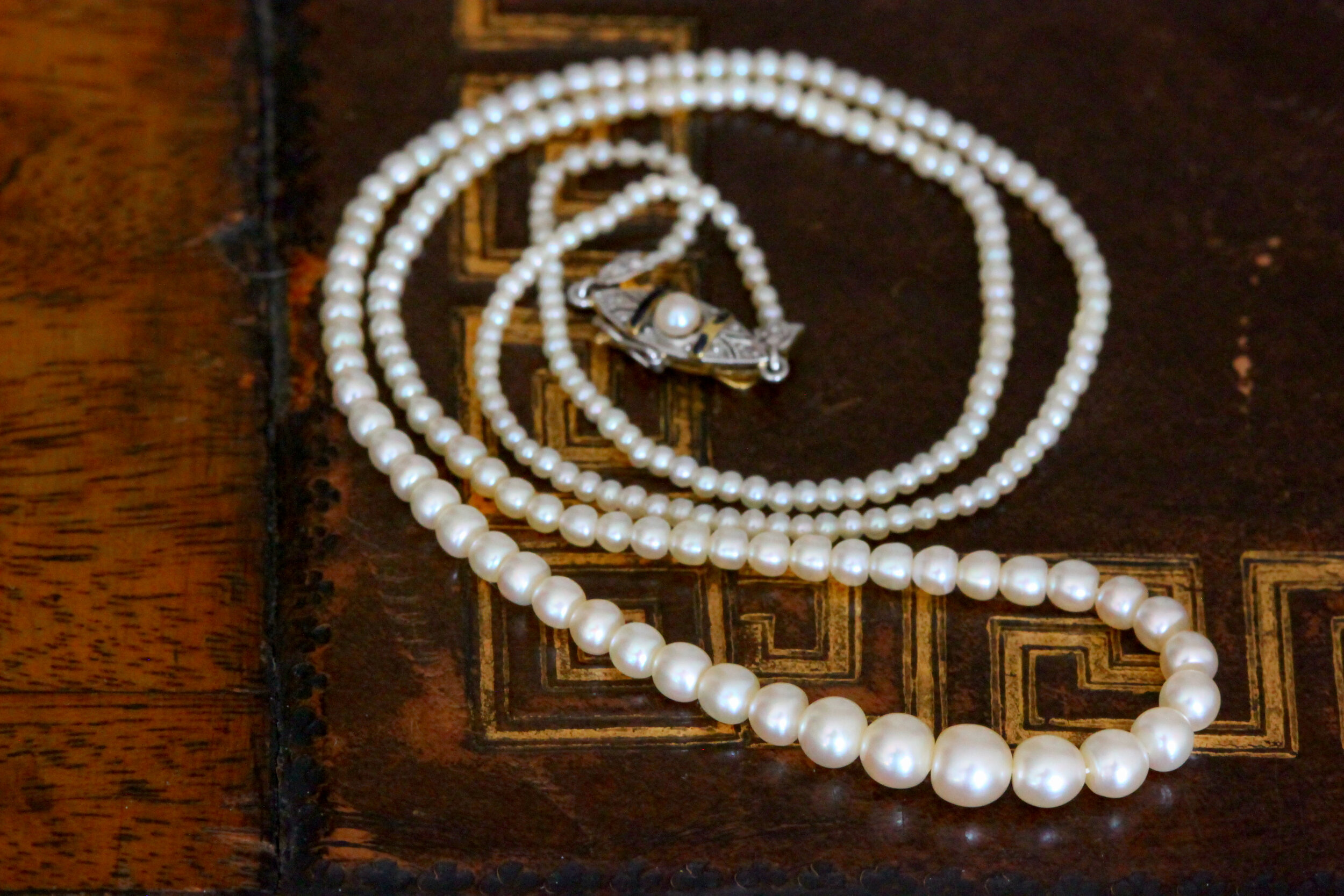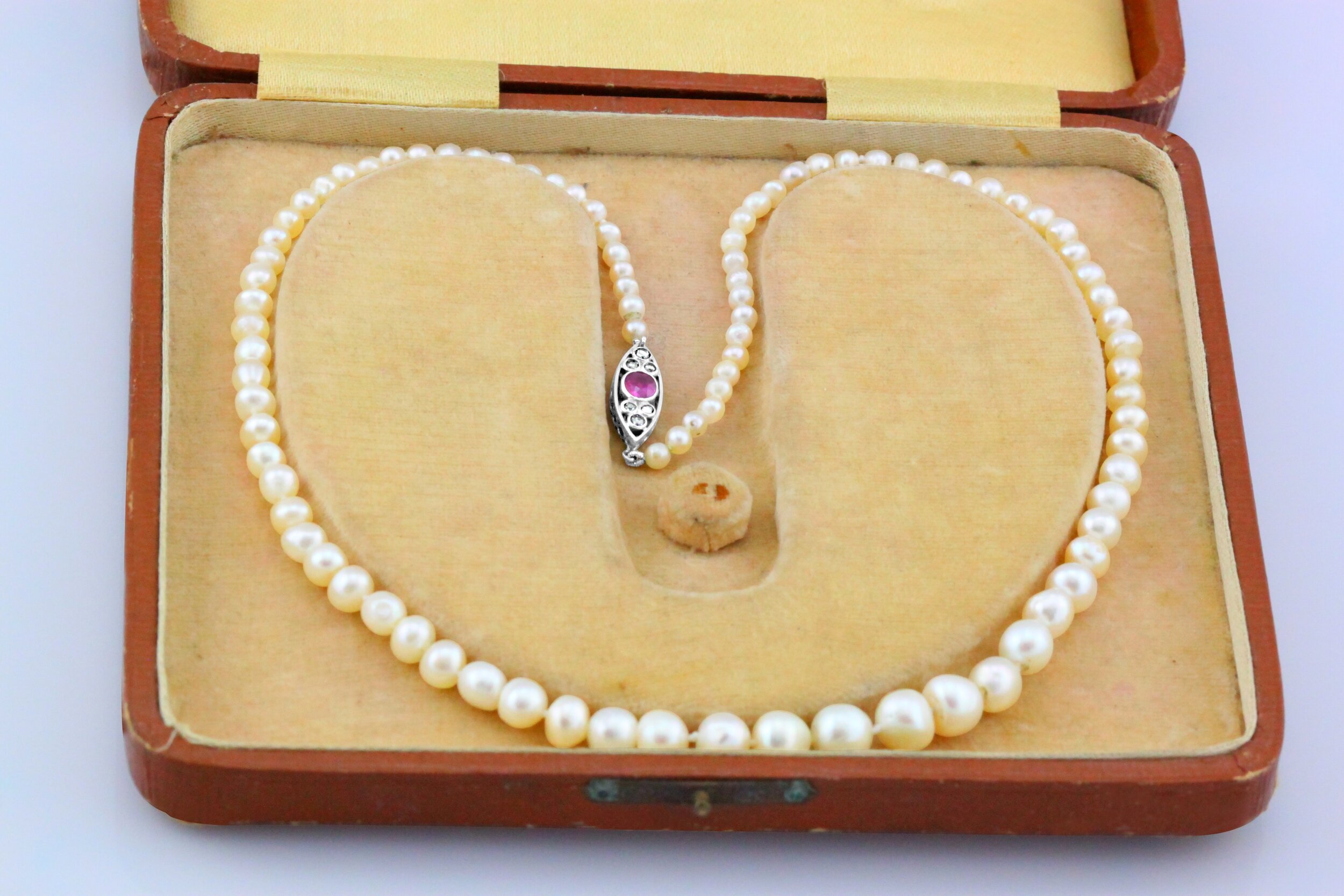Natural Pearls – The Original Made by Mother Nature
More than 120 years after the invention of the process to produce cultured pearls, there is again a very strong demand for natural pearls in the world of fine jewelry enthusiasts. So what are natural pearls, and what makes them so rare, special and exciting for the contemporary jewelry collector?
A small but very fine strand of natural pearls, Swedish, made around 1900-1910.
What are pearls?
Pearls, whether natural or cultured, are organic gems usually created by an aquatic mollusk (clams, oysters, scallops, you name it…) in either freshwater or saltwater. A pearl is created when a foreign object (like a grain of sand, sometimes a parasite) gets inside a mollusk and irritates the soft tissue that lines its shell. The mollusk tries to reduce the potential harm of the forgeign object by coating it with layers of smooth nacre, a crystallized form of calcium carbonate. After layers and layers of nacre coating, a process that can continue for months if not years, the foreign object – an irritant perceived by the oyster as a threat – will be transformed into a beautiful pearl. Traditionally, the most treasured pearls, both natural and cultured, are created in a marine (saltwater) environment by oysters of the genus Pinctada. Freshwater pearls can be fine organic gems as well, but they usually cannot compete with the luster of the finest natural saltwater pearls.
What are natural pearls?
In nature, pearls are created solely ‘by accident, only under conditions as described above. This happens very, very rarely, and for this reason, pearls have been considered extremely rare and valuable in past centuries. Around the year 1900, fine-grade natural pearls were valued at a higher cost per carat than fine colorless diamonds, an extremely rare commodity as well, at that time.
“A cultured pearl is a manmade sphere covered in a thin layer of pearl nacre. In a natural pearl, however, there is no nucleus inside the pearl – the pearl is solid through and through.”
What are cultured pearls?
In order to fully appreciate what natural pearls are, we first need to understand what a cultured pearl is. Since the creation of a natural pearl happens very rarely in nature, humankind found a way to recreate this process in a way that allows pearl farmers to produce cultured pearls in almost unlimited quantities. For this, a so called bead nucleus – a manmade spherical structure – and a mantle-tissue piece are implanted into an oyster, provoking the oyster to coat the artificial core in nacre, hence forming a ‘pearl’ around the manmade basic structure. This process was invented by Mikimoto in 1893, and commercialized in the first decades of the 20th century. From around 1920 onwards, practically every pearl in the market was a cultured pearl produced using the Mikimoto process, making pearls, previously considered more valuable than diamonds, affordable to a much wider group of buyers.
So what exactly is the difference again?
At the end of the day, and stripped of all romance, a cultured pearl is a manmade sphere covered in a thin layer of pearl nacre. In a natural pearl, however, there is no nucleus inside the pearl – the pearl is solid through and through, consisting of countless layers of nacre developed around the original foreign particle (usually tiny!) that prompted the oyster to create a pearl. A natural pearl is made without any human help or intervention. It is a marvel made by mother nature.
The main difference between cultured and natural pearls. Credit: Creative Commons.
Why are natural pearls rare?
Without any human intervention, a gem quality pearl is created in about 1 out of 10,000 Pinctada oysters. And that one oyster containing a pearl is not readily accessible in a pearl oyster farm, but it is out in the open ocean and needs to be found by a highly skilled (and patient!) pearl diver. Hence, in order to create a natural pearl necklace consisting of at least 100 pearls, you need to find and open about one million oysters! In past centuries, pearl diving was a thriving industry in the Persian Gulf region, the predominant source of fine, natural saltwater pearls. Today it practically is a lost art. As a result, most natural pearls in the market nowadays are antique. There is one famous anecdote, most of which is true, that is an impressive testament to the rarity and desirability of true natural pearls: In 1916 (some say 1917), Pierre Cartier, acquired the iconic headquarters of the maison on 5th Avenue New York by trading an exceptional double strand of natural pearls against the by now absolutely priceless landmark building. Much less expensive, but not much less impressive, is our very own natural pearl necklace by Cartier.
“In order to create a natural pearl necklace consisting of at least 100 pearls, you need to find and open about one million oysters!”
Do natural pearls look and feel different from cultured pearls?
Yes! The first thing you will notice when comparing natural and cultured pearls is the weight. Natural pearls, consisting almost entirely of thick pearl nacre, will feel surprisingly heavy and solid in your hand, especially when compared side by side with much more lightweight cultured pearls. With most natural pearls you will also notice differences in shape and size, compared to cultured pearls. Due to their extreme rarity, natural pearls are considered fine grade even when they are much less perfect (less round, perhaps slightly blemished) than what you would expect from cultured pearls. Cultured pearls can be perfectly round because they are formed around a manmade, perfectly spherical bead. In the absence of such a bead, natural pearls can be a little bit more idiosyncratic in shape – more oval, or simply ‘roundish’ instead of perfectly round, and sometimes even pear shaped or ‘baroque’. While off-round shapes are considered unacceptable in cultured pearls, natural pearls are graded more generously, considering the overall beauty of a strand rather than the degree of perfection in every individual pearl.
A fine strand of natural pearls, topped with a Burma ruby clasp, previously sold by Enhoerning Jewelry.
How do I know a strand of pearls is truly natural = not cultured?
While some natural pearls can be identified as non-cultured very easily (often by inspecting the nacre thickness through the holes drilled for stringing…), there are countless ways of ‘faking’ the look and feel of a natural pearl. Therefore the only way to be sure that a strand of pearls is truly natural is to rely on a reputable laboratory report. In the United States, the first choice for a natural pearl report is the Gemological Institute of America (GIA), and there are several other labs around the world that are reliable partners in the identification of natural pearls. Never attempt to purchase a strand of natural pearls without a lab report confirming the natural origin of the material, and the absence of treatments to alter the appearance of the pearls. Even within the jewelry trade, no strand of natural pearls changes hands without a valid lab report.
How can I purchase a strand of true natural pearls?
Most of the natural pearls in the market today are old material, i.e. vintage or antique. Hence your best chance of acquiring a strand of these rare treasures is from an upscale jeweler carrying fine estate pieces. In any case, keep in mind that any legitimate offer of true natural pearls will come with a GIA (or similar) report that is explicitly confirming both the “natural” origin of the pearls and the absence of treatment. We at Enhoerning Jewelry are proud to always keep at least one strand of fine natural pearls in stock. You can browse our current selection of natural pearl necklaces here.







